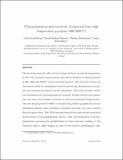| dc.contributor.author | Surup, Gerrit Ralf | |
| dc.contributor.author | Nielsen, Henrik K. | |
| dc.contributor.author | Heidelmann, Markus | |
| dc.contributor.author | Trubetskaya, Anna | |
| dc.date.accessioned | 2018-10-02T08:27:21Z | |
| dc.date.issued | 2018-09-22 | |
| dc.identifier.citation | Surup, Gerrit Ralf, Nielsen, Henrik Kofoed, Heidelmann, Markus, & Anna, Trubetskaya. (2019). Characterization and reactivity of charcoal from high temperature pyrolysis (800–1600 °C). Fuel, 235, 1544-1554. doi: https://doi.org/10.1016/j.fuel.2018.08.092 | en_IE |
| dc.identifier.issn | 1873-7153 | |
| dc.identifier.uri | http://hdl.handle.net/10379/14568 | |
| dc.description.abstract | This study presents the effect of wood origin and heat treatment temperature on the CO2 reactivity, nanostructure and carbon chemistry of chars prepared at 800, 1200, and 1600 °C in slow pyrolysis reactors. The structure of charcoal was characterized by transmission electron microscopy, Raman spectroscopy, mercury intrusion porosimetry and N2 adsorption. The CO2 reactivity of char was investigated by thermogravimetric analysis. Results showed that spruce and oak chars have similar reactivity at all heat treatment temperatures. The oak char prepared at 1600 °C contained long and flat graphene layers and interplanar distance that is similar to graphite and thus, was more ordered than the spruce char. The TEM analysis showed that charcoal had structural characteristics of non-graphitizing carbon. Thus, increasing heat treatment temperature increases the graphitization of char structure, leading to the reactivity that is nearly similar to that of low reactive metallurgical coke. The wood origin, heat treatment temperature, nanostructure, differences in porosity and pore size of char influenced the CO2 reactivity less than the differences in CO2 concentrations. | en_IE |
| dc.description.sponsorship | The authors gratefully acknowledge financial support from Elkem AS, Saint Gobain Ceramic Materials AS, Eramet Norway AS, Kempe Foundation, Björn Wahlströms, and Jernkontoret Stiftelsen. The authors acknowledge the facilities and technical support of Dr. Andras Gorzsas at Umeå University. The German Federal Government, Federal State of Nordrhein-Westfalen, Deutsche Forschungsgemeinschaft (DFG) are acknowledged for their contribution toward the establishment of the Interdisciplinary Center for Analytics on the Nanoscale in the University of Duisburg-Essen. Gundula Stein and Viktor Scherf from GNF Berlin-Adlershof e.V. are acknowledged for many discussions on N2 adsorption analysis. We acknowledge Raymond Mclnerney from University of Limerick for the article proof-reading. | en_IE |
| dc.format | application/pdf | en_IE |
| dc.language.iso | en | en_IE |
| dc.publisher | Elsevier | en_IE |
| dc.relation.ispartof | Fuel | en |
| dc.rights | Attribution-NonCommercial-NoDerivs 3.0 Ireland | |
| dc.rights.uri | https://creativecommons.org/licenses/by-nc-nd/3.0/ie/ | |
| dc.title | Characterization and reactivity of charcoal from high temperature pyrolysis (800–1600 °C) | en_IE |
| dc.type | Article | en_IE |
| dc.date.updated | 2018-09-25T15:27:45Z | |
| dc.identifier.doi | 10.1016/j.fuel.2018.08.092 | |
| dc.local.publishedsource | https://doi.org/10.1016/j.fuel.2018.08.092 | en_IE |
| dc.description.peer-reviewed | peer-reviewed | |
| dc.description.embargo | 2020-09-22 | |
| dc.internal.rssid | 14997200 | |
| dc.local.contact | Anna Trubetskaya, -. - Email: anna.trubetskaya@nuigalway.ie | |
| dc.local.copyrightchecked | Yes | |
| dc.local.version | PUBLISHED | |
| nui.item.downloads | 178 | |


